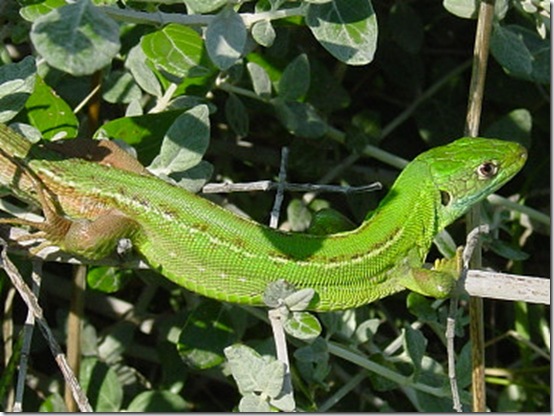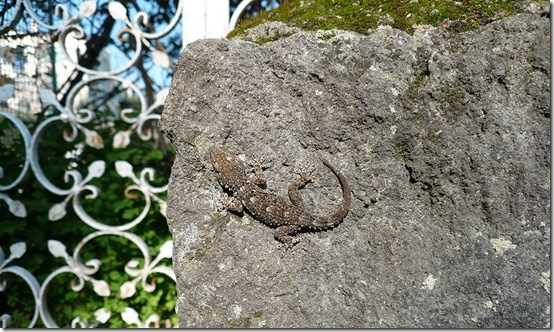Le Lucertole Italiane Posted by Serena on Jun 11, 2011 in Uncategorized
In my last blog “I Serpenti Italiani” we had a look at the most common snakes that you are likely to see here in Italy. Let’s continue with our reptile theme and find out about le più comuni delle lucertole italiane (the most common Italian lizards).
The two lizards that you will see most often, even in towns and cities, are: lucertola muraiola and lucertola campestre both are usually referred to as the Italian wall lizard
Le loro dimensioni variano dai 15 ai 25 cm, compresa la coda. Trovano la tana in buchi nei muri o sotto terra, e appena uscite si riposano al sole per scaldarsi. Sono inattive da ottobre a marzo, ma in giornate particolarmente calde si muovono anche in pieno inverno. Le lucertole hanno la particolarità di poter perdere la coda se questa viene afferrata da un eventuale predatore. Comunque, la coda può in seguito riformarsi, crescendo fino a 2 mm al giorno.
They vary in size from 15 to 25 cm including the tail. They make their dens in holes in walls or underground, and as soon as they come out they rest in the sun to warm themselves up (sounds just like me, in fact we often refer to someone who likes to rest in the sun as una lucertola!). They are inactive from October to March, but on particularly warm days they move about even in the winter (yes definitely sounds like me!). Lizards have the peculiarity of being able to shed their tail if it is grabbed by a possible predator. However, the tail can regenerate itself, growing up to 2mm a day.
So what is the difference between lucertola muraiola and lucertola campestre? Watch this video (in Italian) to find out. Tip: the lizard that you see in the video is a lucertola campestre:
http://www.youtube.com/watch?v=1FxPwHMLjUo
——————————————————————————
More spectacular, but not so easy to find is il ramarro:
Le dimensioni del ramarro sono maggiori di quelle della lucertola muraiola e può raggiungere i 45 cm di lunghezza, coda compresa. Il colore del maschio è verde brillante mentre la femmina è più scura. Nel periodo degli amori la gola del maschio diventa azzurra.
The ramarro is larger than the wall lizard and it can grow up to 45cm, including the tail. The color of the male is brilliant green, whilst the female is darker. In the mating season, the male’s throat becomes azure.
Despite its brilliant coloring the ramarro is much harder to find because it spends most of its time amongst dense vegetation. We usually see them in the early spring when they are just coming out of letargo (hibernation) and before the plants have grown too thick to hide them.
——————————————————————————
Even harder to spot is the geco comune or tarentola:
Il geco è principalmente notturno, ed va a caccia dal tramonto fino alle prime ore dell’alba. Le sue zampe si sono perfettamente adattate ad aderire alle superfici verticali su cui è solito trascorrere il tempo. È addirittura capace di arrampicarsi su superfici molto liscie come il vetro!
The gecko is mainly nocturnal and hunts between sunset and the early hours of dawn. Its feet are perfectly adapted to adhere to the vertical surfaces on which it usually spends its time. It is even capable of climbing up really smooth surfaces such as glass!
The most common place to spot a gecko in my experience is on the wall of a building at night near a streetlight where it hunts for insects. The gecko loves mosquitoes, and can consume up to 2,000 in a single night.

Build vocabulary, practice pronunciation, and more with Transparent Language Online. Available anytime, anywhere, on any device.






Comments:
Gerard Connaughton:
Molto interresante ma dove il video?
Serena:
@Gerard Connaughton Salve Gerard, ecco il video. C`era un problema per cui non lo si vedeva. Adesso l`ho sistemato.
Saluti da Serena
Ron:
Love your articles on snakes and lizards…
Also a help with the language, Thanks.
Ingrid:
Hi, Found un ramarro today (nella provincia di TO). Had never seen one before and your site helped me identify it. Very helpful. Thanks 🙂
Geoff:
@Ingrid Salve Ingrid, benvenuta nel nostro blog. Sono contenta che il mio blog ti sia stato di aiuto.
Saluti da Serena